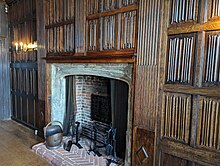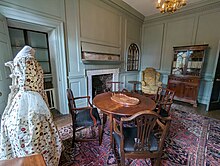Sutton House, London
| Sutton House | |
|---|---|
Red brick | |
| Website | |
| www | |
Listed Building – Grade II* | |
| Designated | 23 April 1951 |
| Reference no. | 1226810 |
Sutton House is a
History
16th century

Originally known as Bryck Place, Sutton House
Machell, a successful businessman and member of the
17th century

Upon Deane's death, the house passed to his niece Olive, who likely rented it to a series of tenants.[11] In the early 1630s, the house was sold to John Milward, a member of the Vintners' Company[12] and later a silk trader in the East India Company.[13] After suffering financial losses, he transferred ownership of the house in 1639 to his daughter Elizabeth and her husband Edward Abbot, a member of the Drapers' Company and director of the East India Company.[14] Abbot also lost the house due to financial difficulties, and in the 1650s the house was acquired by Henry Whittingham, who granted a lease to a prosperous widow named Sarah Freeman.[15] Freeman operated a well-regarded girls' school at Sutton House until her death in 1700.[15] The ownership of the house descended through Whittingham's family to Sarah Wagstaffe, a wealthy widow with four daughters.[16]
18th century

After Sarah Freemen's death, the school continued in operation until 1740, when the lease was granted to a bricklayer and builder named John Cox who updated and later subdivided the house.[17] By the 1750s, two tenants were listed in the property, Timothy Ravenhill and Mary Tooke, a wealthy Huguenot widow, suggesting that the house had been divided.[18] During this period, new sash windows were installed and Georgian features were added to an expanded east wing of the house.[19] During the second half of the century, a significant number of homes were built in the surrounding streets and the house came into the possession of the Ball family,who owned the house through several generations.[20] During that time, the house was occupied by a succession of Huguenot tenants.[21]
19th century
In 1816 the house was acquired by Reverend Thomas Burnet for a boys' school, which was attended by the novelist Edward Bulwer-Lytton[22] and Frederick Young.[23] The building next became Milford House girls' school,[24] which was in operation until 1875.[23] The legal ownership of the estate had grown so complex in the prior two centuries that in the mid-1800s, the Court of Chancery was asked to rule upon the matter, ultimately defining the western half of the property as Sutton House.
20th century
Sutton House was bought by the National Trust in the 1930s with the proceeds of a bequest made by William Alexander Robertson in memory of his two brothers killed in
Rescue

In the mid-1980s the building was squatted and used as a music venue and social centre, known as the Blue House (a decorated wall from this time is preserved within the current museum).[34] After the squatters were evicted the building's condition continued to decline. The Sutton House Society, originally known as the Save Sutton House Campaign, which was formed in March 1987, then began a campaign to rescue the building and open it to the public.[35] Renovations were completed in 1991.[36]
The building remains in use as a museum, as well as housing a café, an art gallery and a book and gift shop.[37] There is an active schools education programme at the house, together with other community programmes. Sutton House was long-listed for the 2004 Gulbenkian Prize.[38] It is registered for the conduct of marriages.[39] The restoration was completed in 1993 and the house fully opened in 1994.[40]
Transport

The closest railway stations are
Notes
- ^ The name is a misattribution to Thomas Sutton, founder of Charterhouse School, who was another notable Hackney resident, in the adjacent Tan House.[1] This was demolished in 1806 to allow for the extension of Sutton Place, a terrace of 16 Georgian Houses (Grade II listed).[2]
- ^ The panelling was stolen in the 1980s while the building was derelict, but was returned to the National Trust by the salvage firm that recognised its exceptional quality.[8]
References
- ^ Belcher 2004, p. 15.
- ^ "Hackney: Homerton and Hackney Wick". www.british-history.ac.uk. 1995.
- ^ Belcher 2004, p. 18.
- ^ Belcher 2004, p. 25.
- ^ Belcher 2004, p. 23.
- ^ Belcher 2004, p. 91.
- ^ a b Belcher 2004, p. 92.
- ^ Wright 2009, p. 52.
- ^ Belcher 2004, p. 103.
- ^ Belcher 2004, p. 95.
- ^ Belcher 2004, p. 114.
- ^ Belcher 2004, p. 115.
- ^ Belcher 2004, p. 116.
- ^ Belcher 2004, p. 118.
- ^ a b Belcher 2004, p. 120.
- ^ Belcher 2004, p. 121.
- ^ Belcher 2004, p. 135.
- ^ Belcher 2004, p. 137.
- ^ Belcher 2004, p. 139.
- ^ Belcher 2004, p. 172.
- ^ Belcher 2004, p. 174.
- ^ Belcher 2004, p. 179.
- ^ a b Belcher 2004, p. 180.
- ^ Hackney: Education, A History of the County of Middlesex: Volume 10: Hackney (1995), pp. 148-165 accessed 26 January 2008.
- ^ a b Belcher 2004, p. 173.
- ^ Belcher 2004, p. 192.
- ^ Hunting 2005, pp. 54–55.
- ^ Belcher 2004, p. 193-194.
- ^ Belcher 2004, p. 212.
- ^ Belcher 2004, p. 213.
- ^ Belcher 2004, p. 214.
- ^ Belcher 2004, p. 216.
- ^ Oakley, Malcolm (29 April 2014). "The History of Sutton House Hackney". East London History. Retrieved 25 April 2019.
- ^ "Delve into the history of Sutton House". National Trust. Retrieved 24 April 2019.
- ^ Belcher 2004, p. 222.
- ^ Sutton House Society Newsletter, June 2007 accessed 23 June 2007
- ^ "Sutton House and Breaker's Yard". National Trust. Retrieved 25 April 2019.
- ^ "The Gulbenkian Prize 2004 - The Museum Prize Trust". www.museumprizetrust.org.uk.
- ^ "Venue hire at Sutton House | London".
- ^ Belcher 2004, p. 26.
Sources
- Belcher, Victor (2004). Sutton House : a Tudor Courtier's House in Hackney. Swindon: English Heritage. ISBN 978-1-873-59256-4.
- Hunting, Penelope (2005). "Cheyne Walk in 1899: Fleetwood Varley's Frieze". The British Art Journal. 6 (1): 52–55. ISSN 1467-2006.
- Wright, Patrick (2009). A Journey Through Ruins: the Last Days of London. Oxford: Oxford University Press. ISBN 978-0-199-54194-2.
Further reading
- Jennifer Jenkins and Patrick James: From Acorn to Oak Tree (Macmillan, 1994)
